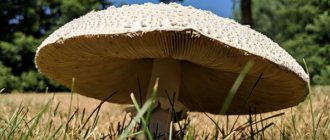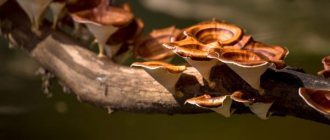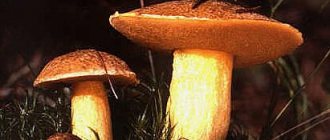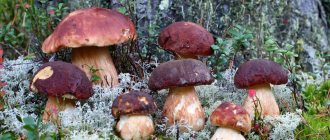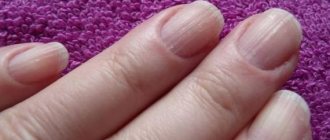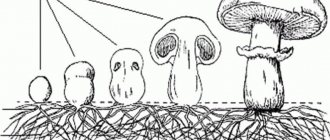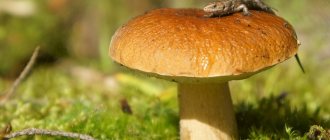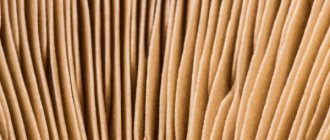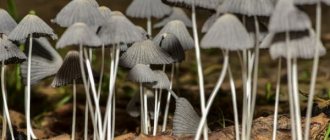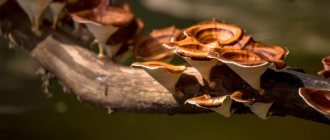4.7
Average rating: 4.7
Total ratings received: 730.
4.7
Average rating: 4.7
Total ratings received: 730.
The kingdom of mushrooms is one of the many in its variety. In this article we will talk about the highest representatives of this kingdom - cap mushrooms. After reading the material, you will learn how representatives of this species reproduce, feed, and how they work.
The structure of a cap mushroom
These organisms are multicellular. They mainly grow in the soil and are saprophytes. However, among them there are parasites that live and feed on wood, as well as symbionts that form a common root with the tree.
From the textbook for grade 5 “Biology” we know that the structure of a cap mushroom consists of a mycelium and a fruiting body.
Mycelium is an organ found in the soil and is presented in the form of thin white threads (hyphae).
They grow in different directions from the center, while the central parts die off over time. Over the years, the mycelium turns into a dense ring.
The part that we used to call a mushroom is actually the fruiting body. The mushroom is the mycelium in the substrate, and the cap on the stalk is the organ for reproduction and dispersal.
TOP 4 articles
who are reading along with this
Lichens
Structure of mushrooms (grade 5)
Mitosis and meiosis
Mitosis diagram
Rice. 1. The structure of a cap mushroom.
Recommendations for collecting mushrooms
Among the cap mushrooms there are both edible and poisonous. Of the edibles, the most valuable are champignons, white mushrooms, boletus mushrooms, boletus mushrooms, boletus mushrooms, and milk mushrooms. Fruiting bodies of different species of mushrooms are formed at different times.
At the end of April - beginning of May, morels and lines appear. A little later - champignons. In mid-June, when the rye is heading, boletus mushrooms appear.
Following them are boletus, boletus, and russula. From the second half of summer until frost, mushrooms of all types form fruiting bodies.
When collecting, it is advisable to handle the mycelium as carefully as possible. There is no need to dig mushrooms out of the soil, as this will damage the mycelium. You should use light, careful movements to twist the fruit tepas out of the soil.
In this case, the mycelium threads are almost not damaged.
If the weather is dry, the fruiting bodies of the mushrooms begin to grow only at the end of summer. As soon as the air temperature drops steadily, their growth stops.
When picking mushrooms, you must use the main rule - if you are not completely sure that the mushroom is edible, it is better not to take it. The fly agaric and toadstool have a high content of toxic substances. Double mushrooms are especially dangerous: false chanterelles and false honey mushrooms and others, since they are very similar to edible ones.
Pale toadstool mushrooms are very similar in appearance. However, the underside of the toadstool's cap is greenish-white, while the champignon's is pink.
The fly agaric has a distinctive bright red cap with white spots, although fly agarics are sometimes found with gray caps.
The porcini mushroom has its own counterpart - the gall mushroom.
However, the upper part of the gall mushroom stump is covered with a pattern in the form of a black or dark gray mesh, and its flesh, unlike the pulp of the porcini mushroom, turns red at the break. False chanterelles are also similar to edible chanterelles, but their caps are smooth, reddish-orange, rather than light yellow like the edible ones. In addition, white juice is released from the broken cap of the false chanterelle.
Edible honey mushrooms have a ring of film on the stump.
False honey mushrooms do not have such a film and their plates under the cap are greenish.
In some years, in some areas, edible mushrooms may contain toxic substances. In addition, old fruiting bodies of edible mushrooms can also become poisonous. It is dangerous to eat mushrooms grown near highways, chemical and other industrial enterprises that pollute the environment with harmful substances. Mushrooms grown in areas contaminated with radionuclides pose a great danger.
The fruiting bodies of fungi are capable of intensively accumulating these substances.
Materials: https://biofile.ru/bio/1103.html
Types of caps
The shape of the cap is fundamental in the taxonomy of mushrooms. To determine the species, the location of the center and the features of the edge of a given organ of the fruiting body are taken into account. Examples of edges are solid, lobed, wavy, ribbed, etc.
The shape of the hat can be:
- conical;
- truncated-conical;
- campanulate;
- ovoid;
- spherical;
- convex;
- flat;
- bent;
- funnel-shaped, etc.
The surface of the cap can also be different; on top it is covered with skin, which serves for protection.
Tangles of mushroom threads form pulp, which also affects the variety. The consistency can be gelatinous, fleshy, leathery, woody, loose or cotton wool-like.
The lower part of the cap is called the hymenophore; it is of the following types:
- lamellar (champignons, russula, chanterelles);
- needle-shaped (oil can);
- tubular (boletus, porcini mushroom, boletus).
Tubular representatives (boletus, boletus) sometimes enter into symbiosis with trees, while mycelial threads entangle the root of the tree and can get inside it. Thus, mushrooms take nutrients and give back water and mineral salts in return.
Rice. 2. Types of hymenophore.
How do spores form in cap mushrooms? It is in the hymenophore that the maturation of spores occurs, with the help of which reproduction occurs. The process of sporulation begins after puberty. The spore-bearing layer (hymenium) is located on the inner surface of the tubes, the outer surface of the spines and plates. At the lower end of the tubes there is a hole (pore), through which spores spill onto the surface and are carried by the wind.
Spores can be carried over long distances; they have been found at an altitude of 3 thousand meters. It happens that the fruiting body is eaten by animals, in which case the spores are not digested, but end up in the soil along with digestive waste.
Features of reproduction
The spores are clearly visible under aging specimens in the form of a circle (with a diameter exactly the size of the cap) made of powder, which has a color characteristic of the species. They, having matured and spilled out of the cap, exactly repeat the pattern of its hymenophore - tubular, lamellar or otherwise (in tinder fungi - labyrinth-like).
Cap mushrooms reproduce by spores
A spore is an analogue of the seed of higher plants, a matrix of one cell containing the entire program of life and development of the organism. Once eaten, it is not digested in the intestines of the eater, but falls on the soil and grows deep into it, giving rise to a new mycelium.
This increases the chance for cunning creatures to spread wider, because the spores, having traveled as free passengers in the animal’s body, will end up in new places, often many kilometers from the previous ones.
From the human intestine, spores are unlikely to get into the soil (rather, into the sewer). But a person throws mushroom trimmings, or even whole specimens: wormy, old and overripe, onto a manure heap or into a compost bin. And after a while, with surprise and joy, he finds there strong champignons or other species that are unpretentious to the growing conditions.
Leg structure
The organ consists of hyphae and is quite durable in its density. According to its location relative to the cap, the leg can be lateral, central or eccentric.
The shape of the leg is:
- straight;
- curved;
- flattened laterally;
- cylindrical.
In structure it can be hollow, cellular, solid, spongy. The main significance of the stem is to carry the cap (reproductive organ) as high as possible above the soil surface.
Rice. 3. Varieties of the internal structure of the leg.
Growing mushrooms in the garden is not at all difficult
Forest beauties don’t even really need light to live - only warmth, moisture and a nutrient substrate. Therefore, it costs almost nothing to create conditions for them to grow - you just need to buy mycelium on a plant or wood substrate, or “settle” the mushroom caps in a suitable place on the site.
And tree species from the class of polypores are implanted into scraps of suitable dead wood by placing the mycelium on special sticks (sent in sterile packaging) into holes drilled in it, followed by sealing them with an inert material.
Oyster mushrooms are successfully cultivated on a plant-straw substrate, and for the sake of such valuable mushrooms as reishi, it would not be a sin to try transplanting the mycelium into a living tree.
general characteristics
Ambient humidity and temperature are of great importance for the growth of cap mushrooms. The optimal humidity level is 50-80%. In this case, not only the soil, but also the air must be moist.
Depending on the species, a certain type of lighting is required. Some require open space (meadows, forest edges), others require sparse forests, and some do not require lighting at all.
Soils for growth can be different: chernozem, gray and brown forest, clayey and loamy, sandy loam and sandy, calcareous.
What have we learned?
In addition to the mycelium, cap mushrooms have a fruiting body, which consists of a stem and a cap. By their shape you can recognize the type of mushroom. At the bottom of the cap there is a hymenophore in which spores are formed. With their help, these organisms reproduce. For growth, the level of humidity and ambient temperature is of great importance.
Previous
BiologyStructure of mushrooms and their diversity (grade 5, biology)
Next
BiologyProtected species of angiosperms (biology, grade 5)
Test on the topic
- /10
Question 1 of 10A species of higher mushrooms that has a fruiting body is called:
Start test
Hall of Fame
To get here, take the test.
- Niyaz Nasyrov
10/10
- Muhammad Elmirzaev
9/10
- Evelina Badma-Khalgaeva
7/10
- Elizaveta Sukhova
10/10
- Artem Butryashkin
7/10
Eating methods
The cap varieties use ready-made organic substances from the environment for nutrition and most often absorb them on the surface of the mycelium from the soil, which is accompanied by the decomposition of wood and forest floor. Many species are characterized by the presence of a symbiotic relationship with the root system of trees or shrubs. The filamentous mycelium entwines the small roots of the tree, penetrates them and, located between the cells, contributes to the formation of mycorrhiza or “fungus root”. Through the mycelium, water with dissolved mineral components is absorbed. Mycorrhiza is found in a significant part of land plants.
Development of the vegetative body of the fungus
So, the vegetative body of the fungus is called mycelium. Once in a moist substrate rich in organic matter, cap mushroom spores germinate. It is from them that the long filaments of the mycelium develop. They grow slowly. Only after accumulating a sufficient amount of nutritious organic and mineral substances does the mycelium form fruiting bodies on the surface, which we call mushrooms. Their rudiments themselves appear in the first month of summer. But they finally develop only with the onset of favorable weather conditions. As a rule, there are a lot of mushrooms in the last month of summer and in autumn, when the rains come.
The feeding of cap species is not at all similar to the processes occurring in algae or green plants. They cannot synthesize the organic substances they need on their own. There is no chlorophyll in their cells. They need ready-made nutrients. Since the vegetative body of the fungus is represented by hyphae, it is they that contribute to the absorption of water with mineral compounds dissolved in it from the substrate. Therefore, cap mushrooms prefer forest soils rich in humus. They grow less frequently in meadows and steppes. Mushrooms take most of the organic substances they need from tree roots. Therefore, most often they grow in close proximity to them.
For example, all lovers of quiet hunting know that porcini mushrooms can always be found near birch, oak and spruce trees. But you need to look for delicious saffron milk caps in pine forests. Boletus grows in birch groves, and boletus grows in aspen groves. This can easily be explained by the fact that mushrooms establish a close relationship with trees. As a rule, it is useful for both types. When a densely branched mycelium entwines the roots of a plant, it tries to penetrate them. But this does not harm the tree at all. The thing is that, located inside the cells, the mycelium sucks water from the soil and, of course, mineral compounds dissolved in it. At the same time, they also enter the root cells, which means they serve as food for the tree. Thus, the overgrown mycelium performs the function of root hairs. This is especially useful for old roots. After all, they no longer have hairs. How is this symbiosis useful for mushrooms? They receive from the plant useful organic compounds that they need for nutrition. Only if there are enough of them, the fruiting bodies of cap mushrooms develop on the surface of the substrate.
Shape of hats
The following main types are distinguished:
- Ovoid
- Ball-shaped
- Hemispherical (semicircular)
- Convex (cushion-shaped)
- Flat (spread)
- Concave
- Conical (tapered)
- Dzvonikovidna
In addition to these basic ones, scientific descriptions may give precise definitions of the shape of the cap, however, the terms may differ among different authors:
|
|
|
In the center of the cap, a bulge is often noticeable - a tubercle; its presence, relative size and shape may be characteristic of a given type of mushroom. The tip of the tubercle can be flat, rounded or sharp (conical).
When determining, it should be taken into account that the shape of the cap can change significantly as the mushroom grows. Many mushrooms that have spherical or convex caps in young fruiting bodies change them to flat or even concave when ripe.
Caps of similar shape can occur in mushrooms belonging to different systematic groups, but many groups are characterized by caps of a certain shape. For example, cushion-shaped - for the boletovidae family, flat with a depression - for the orphan family, ovoid or bell-shaped - for the dung family, cone-shaped - for the genera Mitsena, Psatirella, Galerinus, funnel-shaped - for the talkers.
Death cap
This mushroom is called white and green fly agaric. It is the most dangerous of all poisonous mushrooms. Prefers broad-leaved, coniferous, birch forests and oak forests. It grows in groups and singly from June until frost. You don't see him often.
The diameter of the cap is ten centimeters. In young mushrooms it has a white or grayish color, and in older specimens it is grayish-green. The thin pulp is white in color and has no taste or smell. The leg is long, smooth and thin. It's hollow inside. It has a white color with a yellowish tint and a striped ring.
This mushroom is deadly poisonous. In case of poisoning, the first signs appear after 8-12 hours. But sometimes much later, after 20-40 hours after eating mushrooms.
Chanterelles
These mushrooms are edible, they are so called because of their color. She is bright red. In nature, chanterelles are found with a pale yellow color. Mushrooms prefer to grow at night, where they were not there the day before.
There are many varieties of this mushroom in nature. In Russian forests, the most popular are the common (real), yellow, tubular, and funnel-shaped chanterelles. The habitat is swamp hummocks of deciduous and coniferous forests. Particular preference is given to areas with low grass stand. Chanterelles love to grow in large groups.
The spore-bearing layer of the fungus (hymenium)
The lower part of the cap consists of many small tubes or plates. Hence, most cap mushrooms are divided into tubular and lamellar. The first group includes mushrooms such as porcini mushroom, butterberry, boletus, boletus, moss fly, etc. The second group includes mushrooms, saffron milk cap, russula, etc.
Much less often, instead of tubes or plates, the mushroom has papillae or spines on the lower part of the cap, similar to the spines of a hedgehog, which is why the mushroom received the name blackberry. There are mushrooms that have club-shaped outgrowths or clubs instead of the roundish cap that is common on foot.
The tubes of the fungus are thick and thick, opening outwards with holes or pores. The length of the tributaries of ravdmkh gribo varies. Sometimes "rubmr**1 gvpaR"T"pdpt into short cells, reminiscent of Datedon honeycombs (goat mushroom, pepper mushroom). This coarse one is often easily separated from the pulp of ShLVLKI hriyoga * but in some species it is tightly attached to the pulp and became difficult to separate.
The plates of the mushroom darken around the upper part of the stem and from there the caps go to the bottom. The plates and pipes are attached to the new device. Figure 7 shows how this happens
In lamellar mushrooms. In some mushrooms (for example, champignon) the plates are completely free, they do not reach the stem of the mushroom at all (I), in others they reach it (2), in others (russula) they grow together with the stem (3), in others they adjoin it like would be a tooth (4). Finally, there are types of mushrooms in which the plates descend briefly to the stem (5) or even noticeably descend along it (6), as is observed, for example, in milk mushrooms. In some mushrooms (for example, in umbrellas), the plates form a cartilaginous ring between the stem and the flesh of the cap (7). The plates can be positioned differently in relation to each other. The order of the plates is also a sign of a particular type of fungus. In some species, the plates are connected to each other by short bridges -
| Rice. 7 Connect |
| IOK HATS WITH FOOT |
| In various mushrooms |
Mi, or partitions. This can be observed, for example, in the brown pig.
Spores form on the inner tubes and on both sides of the plates. Their size is equal to several micromillimeters, or microns (micron = 0.001 millimeters). In a mushroom, the number of spores amounts to many millions.
The spores have a wide variety of shapes: from regularly round to ellipsoidal and fusiform, angular, star-shaped.
The color of the spores also varies: white, yellow-brown, brown, purple, reddish and almost black. The shape and color of the spores do not change when boiled in some acids and alkalis. Hence, these two characteristics of spores (color and shape) are one of the constant characteristics when identifying mushrooms.
Can spores be seen with the naked eye? If individual spores, due to their extremely small size, are invisible without a microscope, then in their mass they become accessible to observation. For this purpose, you need to take an adult, mature mushroom, cut off the cap, place its bottom side on a sheet of clean paper and cover it, for example, with a glass or saucer, so as not to somehow move the cap. After a few hours, the spores will spill out of the mushroom cap. Disputes will be visible on paper. The cap of a tubular mushroom will give a finely reticulated pattern of the spore-bearing (hymenial) layer, the cap of a lamellar mushroom will give thin, radially arranged stripes (Fig. 8).
Rice. 8. Imprints of spores of trub'glyt (1} and lamellar three Oo (2)
In the white mushroom, the spores are ocher-yellowish, in the boletus - rusty-brown, in the meadow and forest champignon - purple, in the gall mushroom (similar to white) - pink. Spores are better visible on black paper.
Sometimes the underside of the cap, where the fruiting layer is located, becomes a different color with age. This is due to the change in color of the spores as they mature. For example, in a white mushroom at a young age the bottom of the cap is white, with age it turns yellow and later (in mature mushrooms) becomes greenish, grayish-olive.
Ripe fungal spores disperse. This dispersion occurs mainly with the help of air currents (wind). The spores are equipped with cilia and other devices, thanks to which they spread over considerable distances. Animals also help spread fungal spores. Fungal spores, entering the soil under favorable conditions (sufficient moisture and heat), germinate and give rise to a new mycelium, or mycelium.
There are a number of mushrooms whose fruiting bodies consist of a stalk and a closely fused cellular-mesh cap, reminiscent of a honeycomb. These are morels. In another type of mushroom (strings), the cap has a tortuous-folded surface, reminiscent of the convolutions of the brain (see pictures of these mushrooms in the second part of the book on pp. 213-219).
The spore-bearing layer, or hymenium, is located on the surface of such caps. It consists of special “bags” within which spores develop. Therefore, such mushrooms are called marsupials.
Marsupial mushrooms also include such valuable mushrooms as truffles. They develop under the surface of the soil. Their fruiting bodies are irregularly rounded, like potato tubers. Inside the truffle's fruiting body there are many winding passages lined with a layer of spore bags.
There are round, spherical mushrooms called puffballs (Fig. 9). Their spores are formed inside the fruiting body. When ripe, the fruiting body opens and the spores disperse. The number of the latter in some species is enormous, reaching 5-7 trillion.
In tropical countries, original mushrooms are found, for example, dictyophorans. Because of their unusual shape, they received the figurative name “veiled ladies” (Fig. 10).
Rice. 10. Dictnophora.
The stem, or stump, of the mushroom has a vertical position. Its shape is predominantly round or cylindrical. The mushroom stalk consists of thin, vertically arranged, tightly interconnected thread-like fibers - mushroom hyphae. This fibrous structure of the stem can be seen in mushrooms if you break the stem lengthwise.
| Rice. 9. Raincoat. |
The stems of different types of mushrooms also differ in their internal structure. They are full, completely filled with pulp, for example, boletus. In other types of mushrooms, the legs inside are hollow and empty, for example, in russula, volushek, and saffron milk caps. Some mushrooms have a hollow stalk inside that is lined with loose, spongy pulp.
On the outside, the stem of mushrooms is smooth, sometimes fine-fibrous, sometimes covered with a peculiar pattern in the form of a thin mesh (for example, some forms of porcini mushroom).
The stems of the mushrooms are covered with scales of white, reddish, grayish-blackish color. This can be clearly seen in such common and well-known mushrooms as boletus or boletus.
In some types of mushrooms, you can see a ring on their stem, which sometimes resembles a frill or even a cuff. Butterfly, honey fungus, umbrella mushroom, and fly agaric have such rings. This ring is a remnant of the film (private cover), which in young, still developing fruiting bodies covers the underside of the cap from the edges to the stem. As the fruiting body of the mushroom grows, the film comes off the edges of the cap and hangs on the stem in the form of a ring. This is clearly shown in Figure 11.
In many lamellar mushrooms, the fruiting body at the beginning of development is covered with a common veil, which covers both the stem and the cap together.
As the fruiting body grows, the common cover breaks. The upper part of it remains on the cap in the form of a beard, scales, and the lower part remains at the base of the leg in the form of a swollen, sac-like vagina.
There are mushrooms that have neither a common nor a private covering; they have neither a vagina nor a ring on a stalk (russula, saffron milk cap). The presence of a vagina at the leg, rings on it or their complete absence on the leg -
| G Rice. 11. Initial* development of fruit Tala fly agaric: / - the fruiting body of the mushroom is enclosed in a common shell; 2 - the general shell breaks, small pieces of it remain on the cap; 3—partial veil begins to tear off from the edge of the cap, the general shell in the form of a sac-like vagina. |
| ABOUT. |
| / |
| / |
| Z |
The characteristics of a mushroom are important features in identifying a particular type of mushroom.
If the mushroom is cut or broken, you will notice how the color begins to change at the break point. This property of changing the color of mushroom pulp is quite typical for certain types of mushroom.
At the same time, there are mushrooms that, when broken or cut, do not change their original color at all, for example, porcini mushroom. A change in the color of the mushroom pulp in some species occurs due to the oxidation of the substances contained in it when it comes into contact with atmospheric oxygen.
The size of the stalk (its height and thickness) is a fairly characteristic feature of the mushroom. In tubular mushrooms, the height of the stem is usually greater: on average 7-10 cm. Platinum mushrooms (saffron milk cap, milk mushrooms) are shorter: on average 3-6 cm.
The thickness of the stem (its diameter) for tubular mushrooms is also large, approximately 2-3 cm, for lamellar mushrooms - from 0.5 to 1.5-2 cm.
Chemical composition of mushrooms. For a long time, mushrooms were considered a low-value food product. Meanwhile, chemical analysis showed that they contain various protein substances, animal starch (glycogen), sugar, various minerals and a significant amount of water.
Due to the relatively high content of protein substances in dried mushrooms, they are figuratively called “forest” or “vegetable meat.” It is estimated that 1 kg of fresh mushrooms is equivalent in nutritional value to 100 g of meat.
Mushrooms contain fats and small amounts of various sugary substances, which give mushrooms a pleasant, sweetish taste. Mushrooms such as porcini, saffron milk cap, and champignon are relatively rich in fats.
Lamellar mushrooms from the genus of laticifers (milk mushrooms, saffron milk caps, volnushka, etc.) contain special resins. They are contained in the juice of these mushrooms in the form of tiny droplets, for which it received the name milky juice. The latter gives these mushrooms a unique, pungent taste.
Many minerals were found in the ash of mushrooms (when they were burned): potassium, calcium, phosphorus, iron, sodium, chlorine, etc.
In terms of potassium and phosphorus content, mushrooms are superior to vegetables and some fruits.
Mushrooms contain special odorous, aromatic substances, the so-called extractive substances (obtained from mushrooms when they are digested or evaporated). They give mushrooms a special subtle, pleasant taste. A small addition of fresh or dried mushrooms as a seasoning for food quite dramatically improves its taste.
Mushrooms contain various vitamins. First of all, they contain a noticeable content of vitamins from groups A and B. Vitamin D and even vitamin C were found in mushrooms. When studying white mushrooms, boletuses, boletuses, chanterelles, and honey mushrooms, the presence of a significant amount of vitamin PP was found in them. The absence of this vitamin in food causes a special skin disease (“pellagra”).
Mushrooms are superior to almost all vegetables in their nutritional properties. This is especially noticeable in relation to proteins and fats. The distribution of nutrients in the fruiting bodies of mushrooms is uneven. The caps contain more proteins, fats and sugar than the stem, which is why they are more valuable.
However, it must be pointed out that the body’s absorption of mushroom protein substances is significantly hampered due to the presence of indigestible fiber in them. This fiber is contained in the membranes of mushroom filaments, or hyphae. Therefore, when preparing food from mushrooms, they must be cut into small pieces and chewed well when eating.
In some countries, it is customary to consume dried mushrooms in the form of finely ground powder. This powder is sprinkled on various foods to give them good taste. Mushroom powder is easy to make. To do this, take well-dried mushrooms, such as porcini mushrooms, and grind them into powder in a regular coffee mill. The powder must be sifted through a sieve. It is better to store it in a glass jar.
Marinated porcini mushrooms: recipe (video)
If a plant is used for food, the fungus is called parasitic. Parasitic fungi are quite widespread, so about a third of all fungi are plant parasites. For example, tinder fungi can cause significant harm to forestry and agriculture. Polypore spores penetrate wounds on the tree bark, where mycelium grows, penetrating the wood and using organic cellular substances for nutrition. After some time, fruiting bodies with ripening spores are formed, which can cause infection if they come into contact with damaged wood.
